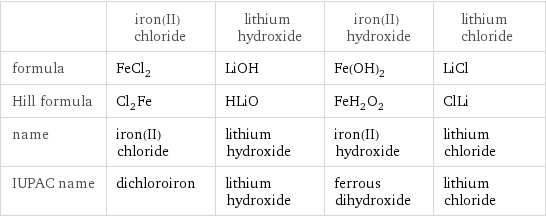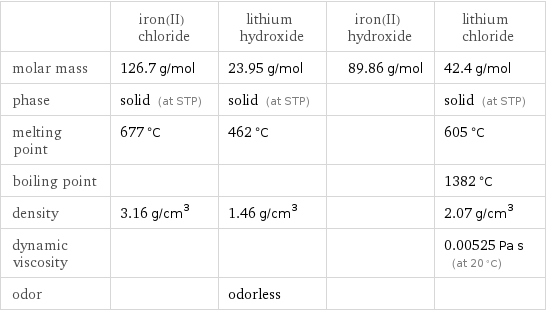Input interpretation

FeCl_2 iron(II) chloride + LiOH lithium hydroxide ⟶ Fe(OH)_2 iron(II) hydroxide + LiCl lithium chloride
Balanced equation

Balance the chemical equation algebraically: FeCl_2 + LiOH ⟶ Fe(OH)_2 + LiCl Add stoichiometric coefficients, c_i, to the reactants and products: c_1 FeCl_2 + c_2 LiOH ⟶ c_3 Fe(OH)_2 + c_4 LiCl Set the number of atoms in the reactants equal to the number of atoms in the products for Cl, Fe, H, Li and O: Cl: | 2 c_1 = c_4 Fe: | c_1 = c_3 H: | c_2 = 2 c_3 Li: | c_2 = c_4 O: | c_2 = 2 c_3 Since the coefficients are relative quantities and underdetermined, choose a coefficient to set arbitrarily. To keep the coefficients small, the arbitrary value is ordinarily one. For instance, set c_1 = 1 and solve the system of equations for the remaining coefficients: c_1 = 1 c_2 = 2 c_3 = 1 c_4 = 2 Substitute the coefficients into the chemical reaction to obtain the balanced equation: Answer: | | FeCl_2 + 2 LiOH ⟶ Fe(OH)_2 + 2 LiCl
Structures

+ ⟶ +
Names

iron(II) chloride + lithium hydroxide ⟶ iron(II) hydroxide + lithium chloride
Equilibrium constant
![Construct the equilibrium constant, K, expression for: FeCl_2 + LiOH ⟶ Fe(OH)_2 + LiCl Plan: • Balance the chemical equation. • Determine the stoichiometric numbers. • Assemble the activity expression for each chemical species. • Use the activity expressions to build the equilibrium constant expression. Write the balanced chemical equation: FeCl_2 + 2 LiOH ⟶ Fe(OH)_2 + 2 LiCl Assign stoichiometric numbers, ν_i, using the stoichiometric coefficients, c_i, from the balanced chemical equation in the following manner: ν_i = -c_i for reactants and ν_i = c_i for products: chemical species | c_i | ν_i FeCl_2 | 1 | -1 LiOH | 2 | -2 Fe(OH)_2 | 1 | 1 LiCl | 2 | 2 Assemble the activity expressions accounting for the state of matter and ν_i: chemical species | c_i | ν_i | activity expression FeCl_2 | 1 | -1 | ([FeCl2])^(-1) LiOH | 2 | -2 | ([LiOH])^(-2) Fe(OH)_2 | 1 | 1 | [Fe(OH)2] LiCl | 2 | 2 | ([LiCl])^2 The equilibrium constant symbol in the concentration basis is: K_c Mulitply the activity expressions to arrive at the K_c expression: Answer: | | K_c = ([FeCl2])^(-1) ([LiOH])^(-2) [Fe(OH)2] ([LiCl])^2 = ([Fe(OH)2] ([LiCl])^2)/([FeCl2] ([LiOH])^2)](../image_source/f80866b0ebe90c59fb37977cf327553c.png)
Construct the equilibrium constant, K, expression for: FeCl_2 + LiOH ⟶ Fe(OH)_2 + LiCl Plan: • Balance the chemical equation. • Determine the stoichiometric numbers. • Assemble the activity expression for each chemical species. • Use the activity expressions to build the equilibrium constant expression. Write the balanced chemical equation: FeCl_2 + 2 LiOH ⟶ Fe(OH)_2 + 2 LiCl Assign stoichiometric numbers, ν_i, using the stoichiometric coefficients, c_i, from the balanced chemical equation in the following manner: ν_i = -c_i for reactants and ν_i = c_i for products: chemical species | c_i | ν_i FeCl_2 | 1 | -1 LiOH | 2 | -2 Fe(OH)_2 | 1 | 1 LiCl | 2 | 2 Assemble the activity expressions accounting for the state of matter and ν_i: chemical species | c_i | ν_i | activity expression FeCl_2 | 1 | -1 | ([FeCl2])^(-1) LiOH | 2 | -2 | ([LiOH])^(-2) Fe(OH)_2 | 1 | 1 | [Fe(OH)2] LiCl | 2 | 2 | ([LiCl])^2 The equilibrium constant symbol in the concentration basis is: K_c Mulitply the activity expressions to arrive at the K_c expression: Answer: | | K_c = ([FeCl2])^(-1) ([LiOH])^(-2) [Fe(OH)2] ([LiCl])^2 = ([Fe(OH)2] ([LiCl])^2)/([FeCl2] ([LiOH])^2)
Rate of reaction
![Construct the rate of reaction expression for: FeCl_2 + LiOH ⟶ Fe(OH)_2 + LiCl Plan: • Balance the chemical equation. • Determine the stoichiometric numbers. • Assemble the rate term for each chemical species. • Write the rate of reaction expression. Write the balanced chemical equation: FeCl_2 + 2 LiOH ⟶ Fe(OH)_2 + 2 LiCl Assign stoichiometric numbers, ν_i, using the stoichiometric coefficients, c_i, from the balanced chemical equation in the following manner: ν_i = -c_i for reactants and ν_i = c_i for products: chemical species | c_i | ν_i FeCl_2 | 1 | -1 LiOH | 2 | -2 Fe(OH)_2 | 1 | 1 LiCl | 2 | 2 The rate term for each chemical species, B_i, is 1/ν_i(Δ[B_i])/(Δt) where [B_i] is the amount concentration and t is time: chemical species | c_i | ν_i | rate term FeCl_2 | 1 | -1 | -(Δ[FeCl2])/(Δt) LiOH | 2 | -2 | -1/2 (Δ[LiOH])/(Δt) Fe(OH)_2 | 1 | 1 | (Δ[Fe(OH)2])/(Δt) LiCl | 2 | 2 | 1/2 (Δ[LiCl])/(Δt) (for infinitesimal rate of change, replace Δ with d) Set the rate terms equal to each other to arrive at the rate expression: Answer: | | rate = -(Δ[FeCl2])/(Δt) = -1/2 (Δ[LiOH])/(Δt) = (Δ[Fe(OH)2])/(Δt) = 1/2 (Δ[LiCl])/(Δt) (assuming constant volume and no accumulation of intermediates or side products)](../image_source/51b16457c277f6b7eda11fc179413552.png)
Construct the rate of reaction expression for: FeCl_2 + LiOH ⟶ Fe(OH)_2 + LiCl Plan: • Balance the chemical equation. • Determine the stoichiometric numbers. • Assemble the rate term for each chemical species. • Write the rate of reaction expression. Write the balanced chemical equation: FeCl_2 + 2 LiOH ⟶ Fe(OH)_2 + 2 LiCl Assign stoichiometric numbers, ν_i, using the stoichiometric coefficients, c_i, from the balanced chemical equation in the following manner: ν_i = -c_i for reactants and ν_i = c_i for products: chemical species | c_i | ν_i FeCl_2 | 1 | -1 LiOH | 2 | -2 Fe(OH)_2 | 1 | 1 LiCl | 2 | 2 The rate term for each chemical species, B_i, is 1/ν_i(Δ[B_i])/(Δt) where [B_i] is the amount concentration and t is time: chemical species | c_i | ν_i | rate term FeCl_2 | 1 | -1 | -(Δ[FeCl2])/(Δt) LiOH | 2 | -2 | -1/2 (Δ[LiOH])/(Δt) Fe(OH)_2 | 1 | 1 | (Δ[Fe(OH)2])/(Δt) LiCl | 2 | 2 | 1/2 (Δ[LiCl])/(Δt) (for infinitesimal rate of change, replace Δ with d) Set the rate terms equal to each other to arrive at the rate expression: Answer: | | rate = -(Δ[FeCl2])/(Δt) = -1/2 (Δ[LiOH])/(Δt) = (Δ[Fe(OH)2])/(Δt) = 1/2 (Δ[LiCl])/(Δt) (assuming constant volume and no accumulation of intermediates or side products)
Chemical names and formulas

| iron(II) chloride | lithium hydroxide | iron(II) hydroxide | lithium chloride formula | FeCl_2 | LiOH | Fe(OH)_2 | LiCl Hill formula | Cl_2Fe | HLiO | FeH_2O_2 | ClLi name | iron(II) chloride | lithium hydroxide | iron(II) hydroxide | lithium chloride IUPAC name | dichloroiron | lithium hydroxide | ferrous dihydroxide | lithium chloride
Substance properties

| iron(II) chloride | lithium hydroxide | iron(II) hydroxide | lithium chloride molar mass | 126.7 g/mol | 23.95 g/mol | 89.86 g/mol | 42.4 g/mol phase | solid (at STP) | solid (at STP) | | solid (at STP) melting point | 677 °C | 462 °C | | 605 °C boiling point | | | | 1382 °C density | 3.16 g/cm^3 | 1.46 g/cm^3 | | 2.07 g/cm^3 dynamic viscosity | | | | 0.00525 Pa s (at 20 °C) odor | | odorless | |
Units
